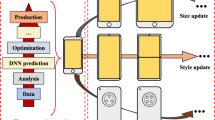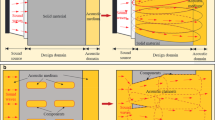Abstract
In this study, we developed an acoustic topology optimization using moving morphable components (MMCs) for the design of two-dimensional sound reduction structures. MMC-based topology optimization has been developed for structural topology optimization; however, no extant study on the design of sound reduction structures has utilized MMC-based topology optimization. Instead of directly changing the distribution of pixel-wise materials to form the shape of a structure, MMC-based topology optimization changes the geometric and positional parameters of MMCs and forms the shape of a structure through the overlapping of MMCs. In this study, finite element analysis based on the Helmholtz equation was performed to calculate the acoustic performance of sound reduction structures. To complement the unsatisfactory performance of designs by local optimal points, we evaluated many designs optimized under different design conditions and optimization settings with respect to the original design condition. We also devised additional design procedures to improve the acoustic performance of sound reduction structures by exploring a lot of design samples modified from the designs based on MMC-based topology optimization. Owing to the rather long time required for repeated performance calculations, the performance was estimated by using a multilayer perceptron to roughly select the design samples that need to be evaluated by finite element analysis. Design examples for barrier structures and duct internal structures were considered to demonstrate the validity of the proposed approach.













(source position (1 m, 0 m) and measurement area “Mid 3”) in the barrier example using different objective functions














Similar content being viewed by others
Data availability
Not applicable.
Code availability
Not applicable.
References
Chang YC, Chiu MC, Wu MR (2018) Acoustical assessment of automotive mufflers using FEM, neural networks, and a genetic algorithm. Arch Acoust 43(3):517–529
Christiansen RE, Lazarov BS, Jensen JS, Sigmund O (2015) Creating geometrically robust designs for highly sensitive problems using topology optimization. Struct Multidisc Optim 52(4):737–754
Deng JD, Chen W (2016) Design for structural flexibility using connected morphable components based topology optimization. Sci China Technol Sc 59(6):839–851
Duhring MB, Jensen JS, Sigmund O (2008) Acoustic design by topology optimization. J Sound Vib 317(3–5):557–575
Durali M, Delnavaz A (2005) BEM/FEM simulation of acoustic field and shape optimization of submarine using neural network and genetic algorithm. Proceedings of the 2004 International Symposium on Underwater Technology (IEEE Cat. No.04EX869)
Goo S, Wang S, Kook J, Koo K, Hyun J (2017) Topology optimization of bounded acoustic problems using the hybrid finite element-wave based method. Comput Method Appl M 313:834–856
Guo X, Zhang WS, Zhong WL (2014) Doing topology optimization explicitly and geometrically-a new moving morphable components based framework. J Appl Mech-T Asme Doi 10(1115/1):4027609
Guo X, Zhang WS, Zhang J, Yuan J (2016b) Explicit structural topology optimization based on moving morphable components (MMC) with curved skeletons. Comput Method Appl M 310:711–748
Guo X, Li W, Iorio F (2016a) Convolutional neural networks for steady flow approximation. Proceedings of the 22nd ACM SIGKDD International Conference on Knowledge Discovery and Data Mining
Kim KH, Yoon GH (2020) Aeroacoustic topology optimization of noise barrier based on Lighthill's acoustic analogy. J Sound Vib 483
Kim KH, Yoon GH (2015) Optimal rigid and porous material distributions for noise barrier by acoustic topology optimization. J Sound Vib 339:123–142
Kook J, Koo K, Hyun J, Jensen JS, Wang S (2012) Acoustical topology optimization for Zwicker’s loudness model - application to noise barriers. Comput Method Appl M 237:130–151
Kook J, Jensen JS, Wang S (2013) Acoustical topology optimization of Zwicker’s loudness with Pade approximation. Comput Method Appl M 255:40–66
Lee JW (2015) Optimal topology of reactive muffler achieving target transmission loss values: design and experiment. Appl Acoust 88:104–113
Lee JW, Kim YY (2009) Topology optimization of muffler internal partitions for improving acoustical attenuation performance. Int J Numer Meth Eng 80(4):455–477
Lei X, Liu C, Du ZL, Zhang WS, Guo X (2019) Machine learning-driven real-time topology optimization under moving morphable component-based framework. J Appl Mech-T Asme https://doi.org/10.1115/1.4041319
Li BT, Huang CJ, Li X, Zheng S, Hong J (2019) Non-iterative structural topology optimization using deep learning. Comput Aided Design 115:172–180
Lian RC, Jing SK, He ZJ, Shi ZF, Song GH (2020) An accelerating convergence rate method for moving morphable components. Math Probl Eng 2020
Liang L, Liu ML, Martin C, Sun W (2018) A deep learning approach to estimate stress distribution: a fast and accurate surrogate of finite-element analysis. J R Soc Interface 15(138)
Nie ZG, Jiang HL, Kara LB (2020) Stress field prediction in cantilevered structures using convolutional neural networks. J Comput Inf Sci Eng 20(1)
Oh S, Jung Y, Kim S, Lee I, Kang N (2019) Deep generative design: Integration of topology optimization and generative models. J Mech Design 141(11)
Rai MM, Madavan NK (2001) Application of artificial neural networks to the design of turbomachinery airfoils. J Propul Power 17(1):176–183
Sosnovik I, Oseledets I (2019) Neural networks for topology optimization. Russ J Numer Anal M 34(4):215–223
Svanberg K (1987) The method of moving asymptotes - a new method for structural optimization. Int J Numer Meth Eng 24(2):359–373
Svanberg K (1998) The method of moving asymptotes - modelling aspects and solution schemes. Lecture notes for the DCAMM course
Svanberg K (2007) MMA and GCMMA - two methods for nolinear optimization. Technical report
Takalloozadeh M, Yoon GH (2017) Implementation of topological derivative in the moving morphable components approach. Finite Elem Anal Des 134:16–26
Ulu E, Zhang RS, Kara LB (2016) A data-driven investigation and estimation of optimal topologies under variable loading configurations. Comp M Bio Bio E-Iv 4(2):61–72
Yahya MN, Otsuru T, Tomiku R, Okozono T (2010) Investigation the capability of neural network in predicting reverberation time on classroom. International Journal of Sustainable Construction Engineering and Technology 1(1):19–32
Yilmaz E, German B (2017) A convolutional neural network approach to training predictors for airfoil performance. 18th AIAA/ISSMO Multidisciplinary Analysis and Optimization Conference
Yoon GH (2013) Acoustic topology optimization of fibrous material with Delany-Bazley empirical material formulation. J Sound Vib 332(5):1172–1187
Yoon GH, Choi H, Hur S (2018) Multiphysics topology optimization for piezoelectric acoustic focuser. Comput Method Appl M 332:600–623
Yu Y, Hur T, Jung J, Jang IG (2019) Deep learning for determining a near-optimal topological design without any iteration. Struct Multidisc Optim 59(3):787–799
Zhang WS, Yuan J, Zhang J, Guo X (2016) A new topology optimization approach based on moving morphable components (MMC) and the ersatz material model. Struct Multidisc Optim 53(6):1243–1260
Zhang WS, Li D, Zhou JH, Du ZL, Li BJ, Guo X (2018a) A moving morphable void (MMV)-based explicit approach for topology optimization considering stress constraints. Comput Method Appl M 334:381–413
Zhang Y, Sung W, Mavris D (2018b) Application of convolutional neural network to predict airfoil lift coefficient. 2018 AIAA/ASCE/AHS/ASC Structures, Structural Dynamics, and Materials Conference
Zheng S, Fan HJ, Zhang ZY, Tian ZQ, Jia K (2021a) Accurate and real-time structural topology prediction driven by deep learning under moving morphable component-based framework. Appl Math Model 97:522–535
Zheng S, He ZZ, Liu HL (2021b) Generating three-dimensional structural topologies via a U-Net convolutional neural network. Thin Wall Struct 159:107263
Funding
This work was supported by the National Research Foundation of Korea (NRF) grant funded by the Korea government (MSIT) (NRF-2019R1A2C2084974).
Author information
Authors and Affiliations
Contributions
Conceptualization and methodology: Ki Hyun Kim and Gil Ho Yoon; Investigation and writing: Ki Hyun Kim; Review: Gil Ho Yoon; Funding acquisition and supervision: Gil Ho Yoon.
Corresponding author
Ethics declarations
Conflict of interest
The authors declare that they have no conflict of interest.
Ethical approval
Not applicable.
Replication of results
The presented results were mainly obtained using our in-house MATLAB codes and may be provided on reasonable request.
Consent to participate
Not applicable.
Consent for publication
Not applicable.
Additional information
Responsible Editor: Xu Guo
Publisher's Note
Springer Nature remains neutral with regard to jurisdictional claims in published maps and institutional affiliations.
Rights and permissions
About this article
Cite this article
Kim, K.H., Yoon, G.H. Acoustic topology optimization using moving morphable components in neural network-based design. Struct Multidisc Optim 65, 47 (2022). https://doi.org/10.1007/s00158-021-03137-1
Received:
Revised:
Accepted:
Published:
DOI: https://doi.org/10.1007/s00158-021-03137-1




